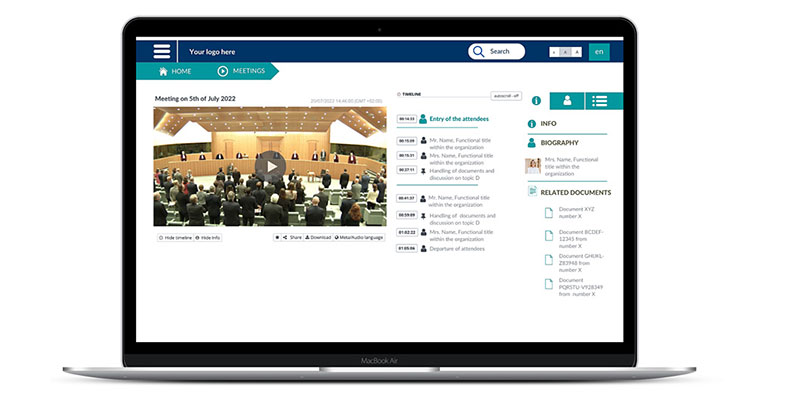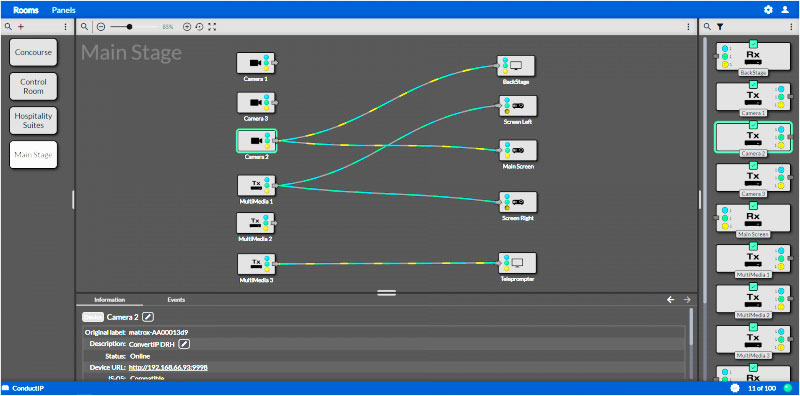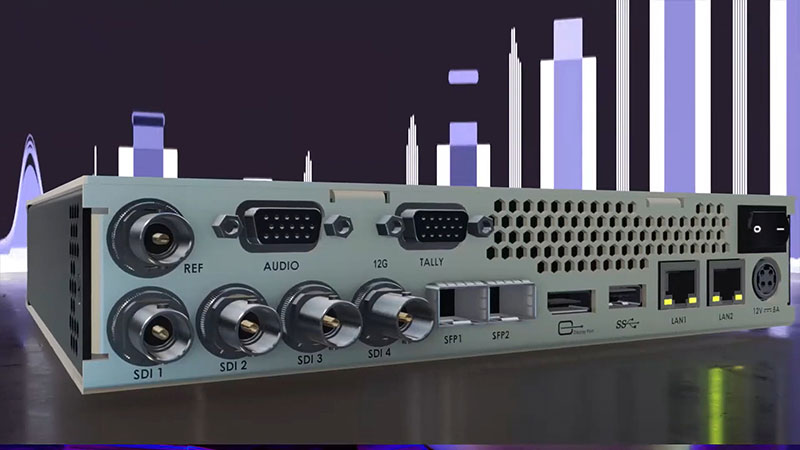Matrox showed broadcast tools at IBC to support ST 2110 workflows and remote productions and operations, plus developer tools giving OEMs flexibility when building agile new systems.

Arbor’s interface for their conference recording and streaming services, using Matrox ST 2110 NIC cards.
Matrox Video showed tools at IBC 2022 that broadcasters can use to design and deploy live production workflows, on-premises and cloud-based, as well as developer tools that give OEMs flexibility when building agile new systems.
ConvertIP was shown for the first time at IBC, a standalone ST 2110 converter that integrates and converts ST 2110 IP signals, which can then be used to monitor ST 2110-20 and ST 2110-22 sources on HDMI or SDI monitors. The single piece of hardware can be re-configured as an encoder or decoder using standard SFPs, and supports up to 25 Gbps of connectivity to deliver uncompressed 4K video over ST 2110. A JPEG XS license is available as an option.
ConvertIP is NMOS-aware and prepared to work with the IPMX (Internet Protocol Media Experience) standards for AV over IP. Aiming for interoperability, simpler infrastructure and scalability, IPMX is based on the ST 2110 standards and NMOS specifications, but adds capabilities specifically for Pro AV workflows. IPMX is used to transport and control compressed and uncompressed video and audio, including 4Kp60 with 4:4:4 colour, over standard 1 GbE networks, with very low latency. It supports resolutions from SD up to 8K or higher with enough flexibility to operate on 10G, 25G, 40G and 100G networks.
Networking with CovertIP is simplified to support either copper- or fibre-based networks. The ConvertIP Command Centre and ConvertIP Manager web-based software applications are included to manage the devices, and a ConductIP software license can be purchased for discovery and routing. The form factor is compact, mounting to the back of a monitor or in a rack, and power is via PoE+ with optional redundancy support.

Matrox Monarch EDGE, Extio 3 IP KVM extenders and ConvertIP (L - R)
At IBC, ConvertIP was also featured at the IP Showcase, demonstrating interoperability with other new ST 2110 systems for open standards-based IP infrastructures.
Remote Operations, Production and Cloud Networks
Remote production and cloud-based networking were major topics at IBC. The Matrox Monarch EDGE encoder and decoder appliances, equipped with tally and talkback, 4K and genlock support, are purpose-built for remote production and contribution environments. They can be used in combination with the GlobalM cloud-based SRT streaming platform, which is designed for high availability, scalable routing and monitoring systems, to form an orchestration network. This set-up can serve as a cost-effective approach to acquiring and sharing high-quality, low-latency contribution streams via the cloud for REMI productions.
Monarch EDGE also participated in the Grass Valley Partner Pavilion, combined with Grass Valley’s Agile Media Processing Platform (AMPP) by feeding high-quality, low latency contribution streams for scalable, cloud-based live productions.
Also serving distributed teams and staff, Extio 3 IP KVM extenders facilitate remote access and connectivity by supporting secure, smooth 4Kp60 4:4:4, up to quad 1080p60 4:4:4, video extension and switching over IP while keeping bitrates very low. Extio 3 IP KVMs work over standard and existing 1 GbE networks, avoiding the need to invest time, labour and financial resources to set up new infrastructure. Their compatibility with standard network switches also helps to lower the total cost of ownership to deliver scalable KVM matrix switching.

ConductIP software interface for discovery and routing.
Flexibility for Customisation and Transitioning
The Matrox hardware and software developer portfolio has been designed to give OEMs flexibility when building custom systems that enable broadcast customers to transition from analogue to SDI, SD to HD to UHD, and SDI to ST 2110. In that position, Matrox also eases the transition for OEMs and broadcasters toward virtual equipment rooms in the cloud to deliver live, low-latency, uncompressed broadcast productions.
Arbor, a Dutch software developer of audio and video applications, with a speciality in conference recording, archiving and streaming services, launched a new IP SMPTE 2110 standards-based software portfolio built on Matrox ST 2110 hardware and software. In particular, the new applications make use of Matrox Video's most recent generation of ST 2110 network interface controller (NIC) cards.
Among Arbor’s clients are European government agencies and organisations, who are using Arbor’s products and services to produce broadcast-grade audio and video recordings while maintaining complete control over all audio and video content. The interface allows authorised users to manage, search and exchange metadata information – including dates, agenda points, speaker and lecture notes.
Geert Van den Bossche, key account manager at Arbor notes that more organisations are migrating to IP-based infrastructures to improve media management workflows, and now cite the SMPTE ST 2110 suite of standards, professional broadcast-quality video and future-proof platforms as essential requirements. “Matrox’s comprehensive ST 2110 capabilities meet all of these criteria, and also allow us to turnaround and bring to market a new series of IP-based systems, very quickly.”

Matrox Monarch EDGE connectivity.
Simple and Unified
Matrox ST 2110 tools aim to simplify the design of scalable 10 GbE and 25 GbE IP systems based on COTS hardware. Matrox ST 2110 NIC cards, for instance, offload all packet processing required for ST 2110-20, ST 2110-30, ST 2110-31 and ST 2110-40, as well as ST 2022-7 redundancy, to free up system resources.
Meanwhile, the Matrox DSX SDK makes sure that demanding recording or streaming operations remain reliable and stable. Setting out a unified architecture common across all Matrox ST 2110 NIC, SDI I/O and H.264 codec cards, the DSX SDK supports key functions such as file reading/writing, memory management, plus a range of file formats, codecs and effects needed to facilitate agile development. The DSX SDK is continuously maintained to synchronise with changes and additions to the ST 2110 specification so that users’ platforms stay up-to-date.
Geert Van den Bossche said, “Matrox’s DSX SDK tools helped us immensely in the development process. We did not have to worry about making the deep, low-level developments ourselves to include features such as ST-2059 PTP timing, ST 2110-21 traffic shaping and delivery timing, or NMOS support. This reduced the complexity of building an ST 2110 solution from the ground up. We also see the new Matrox ConvertIP ST 2110 converters playing a valuable role in many projects to monitor IP content within ST 2110 networking infrastructures.” www.matrox.com/video




















